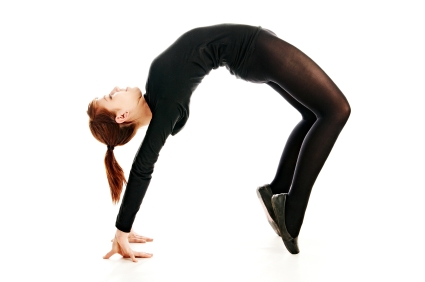
As with ACL injuries, female athletes are more prone than their male counterparts to small, hairline fractures of the lower (lumbar) spine, usually from overtraining (e.g. overuse injuries) or improper loading of the spine. Because such injuries can be misdiagnosed, it is important for coaches and parents to recognize the symptoms and seek appropriate medical treatment.
Common causes
The types of spinal fractures suffered by female athletes are most often found in sports involving a lot of bending of the back and therefore the potential for lumbar hyperextension. Females generally have more ligamentous laxity than males, therefore, they can extend their backs into areas of greater risk. While this bony contact is not harmful with day-to-day tasks, overloading the structures of the back consistently can cause breakdown.
Here are a few examples of where back hyperextension is common:
- Gymnastics (series of flips)
- Soccer (goal kicks)
- Volleyball (jump serve)
- Tennis (overhand serve)
The motions in these sports are very common, but when combined with the following predisposing factors, injury can occur:
- Overtraining
- Playing through the pain
- Weak abdominal musculature
- Poor body mechanics
- Natural excessive flexibility
- Swayback posture (butt out, chest out)
When the spine is extended too much and too frequently, the pressure on weight-bearing structures results in microtrauma. Females athletes often will hyperextend to generate more velocity on a tennis or volleyball serve, kick a ball farther, or generate more speed while completing a series of back flips. While harmless when done infrequently, relying on this motion excessively can lead to problems.
Chronic back pain
There are many signs and symptoms of small spinal fractures, but they are not the focal point for parents and coaches. The one thing parents and coaches can do to is to follow this one injury concept: chronic back pain is not normal, nor should be accepted among young female athletes.
If a young athlete is having chronic back pain (more than a week), she should see a doctor if she has signs of any of the following:
- Point tenderness over one spot or the spine
- Difficulty sleeping
- Pain while wearing a school backpack
- Pain when extending the back
- Pain walking up and down stairs
- Pain when landing from a jump or while running
- Pain that does not go away with rest
The aches and pains adults have with sedentary jobs, out of shape muscles, and aging spines are not common to young athletes. Young female athletes have very healthy, strong, and resilient spines that can easily handle the pressures of day-to- day activity, as well as competitive sports. Chronic back pain is a red flag for coaches and parents to seek medical attention. Allowing a medical professional to determine if there is any underlying problem is critical to prevent further damage.
Rehabilitation
The most important thing an athlete can do in the rehabilitation process is GET TO THE DOCTOR AS SOON AS POSSIBLE.
Rehabilitation will involve:
- Core strengthening
- Body mechanics training
- Postural training
- Learning to avoid certain positions
- Changing daily routine (example - not carrying a heavy book bag or backpack)
- Lower body strengthening
- Massage therapy
- Other therapy modalities (heat, cold, electrical stimulation)
None of these are as important, however, as seeing a doctor or sports medicine specialist. Physical therapists cannot perform magic on an athlete that has been hurting for a year. It may takes months to get back to pain-free competition if conditions are allowed to linger for so long. A qualified physical therapist can educate any young athlete how to prevent the problem from happening again, but it is far easier to have that talk when the healing time frame is a couple weeks as opposed to "wait till next season."
Final tips
Finally, if your young athlete gets a sore back from running 5 miles, don't jump on the Internet to try to diagnose them yourself as having a vertebral fracture and throw a back brace on them. If your young gymnast, soccer player, or volleyball player complains of an aching back week after week and is not sleeping, a small co-pay and a trip to the doctor is your best move.
Keith Cronin is a physical therapist in the St. Louis area and a MomsTeam expert.
Created October 15, 2010, updated January 4, 2012








